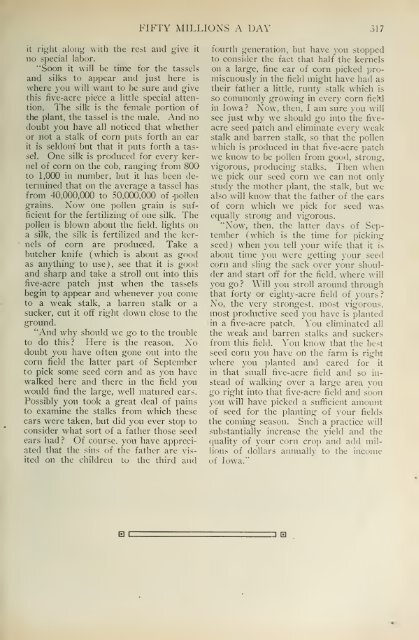Create successful ePaper yourself
Turn your PDF publications into a flip-book with our unique Google optimized e-Paper software.
FIFTY MILLIONS A DAY .317<br />
it right aloHi;- with the rest and give it<br />
no special labor.<br />
"Soon it will be time for the tassels<br />
and silks to appear and just here is<br />
where you will want to be sure and give<br />
this five-acre piece a little special attention.<br />
The silk is the female portion of<br />
the plant, the tassel is the male. And no<br />
doubt you have all noticed that whether<br />
or not a stalk of corn puts forth an ear<br />
it is seldom but that it puts forth a tassel.<br />
One silk is produced for every kernel<br />
of corn on the cob. ranging from 80Q<br />
to 1,000 in number, but it has been determined<br />
that on the average a tassel has<br />
from 40,000,000 to 50,000,000 of -pollen<br />
g'rains. Now one pollen grain is sufficient<br />
for the fertilizing of one silk. The<br />
pollen is blown about the field, lights on<br />
a silk, the silk is fertilized and the kernels<br />
of corn are produced. Take a<br />
butcher knife (which is about as good<br />
as anything to use), see that it is good<br />
and sharp and take a stroll out into this<br />
five-acre patch just when the rassels<br />
begin to appear and whenever you come<br />
to a weak stalk, a barren stalk or a<br />
sucker, cut it off right down close to the<br />
ground.<br />
"And why should we go to the trouble<br />
to do this? Here is the reason. Xo<br />
doubt you have often gone out into the<br />
corn field the latter part of September<br />
to pick some seed corn and as you have<br />
walked here and there in the field you<br />
would find the large, well matured ears.<br />
Possibly you took a great deal of pains<br />
to examine the stalks from which these<br />
ears were taken, but did you ever stop to<br />
consider what sort of a father those seed<br />
ears had? Of course, you have apj^reciated<br />
that the sins of the father are visited<br />
on the children to the third and<br />
fourth generation, but have you stopped<br />
to consider the fact that half the kernels<br />
on a large, fine ear of corn picked promiscuously<br />
in the field might have had as<br />
their father a little, runty stalk which is<br />
so commonly growing in every corn fieltl<br />
in Iowa? Now, then, I am sure you will<br />
see just why we should go into the fiveacre<br />
seed patch and eliminate every weak<br />
stalk and barren stalk, so that the pollen<br />
which is produced in that five-acre patch<br />
we know to be pollen from good, strong,<br />
vigorous, producing stalks. Then w-hen<br />
we pick our seed corn we can not only<br />
study the mother j^lant, the stalk, but we<br />
also will know that the father of the ears<br />
of corn which we pick for seed was<br />
equally strong and vigorous.<br />
"Now, then, the latter days of Se])-<br />
tember (which is the time for picking<br />
seed) when you tell your wife that it is<br />
about time you were getting your seed<br />
corn and sling the sack over your shoulder<br />
and start oft' for the field, where will<br />
you go? Will you stroll around through<br />
that forty or eighty-acre field of yours ?<br />
No, the very strongest, most vigorous,<br />
most productive seed you have is planted<br />
in a five-acre patch. You eliminated all<br />
the weak and barren stalks and suckers<br />
from this field. You know that the best<br />
seed corn you have on the farm is right<br />
where you planted and cared for it<br />
in that small five-acre field and so instead<br />
of walking over a large area you<br />
go right into that five-acre field and sot)n<br />
you will have picked a sufficient amount<br />
of seed for the planting of vour fields<br />
the coming season. Such a practice will<br />
substantially increase the yiekl and the<br />
quality of your corn crop and add millions<br />
of dollars annually to the income<br />
of Iowa."<br />
Q C<br />
3 B
















